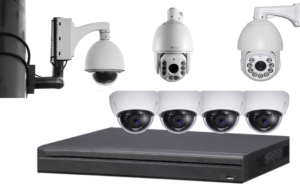Dome Security Cameras Performance
When selecting security camera systems for your business, it’s vital to understand the distinctions between types and models. You wouldn’t want to put a bullet security camera in a 20×20 workstation, for example. Its shorter field of view and longer distance make it more suited for an outdoor setting. You would not want to install a dome security camera on a parking lot since the broad angle lens would fail to catch events that are taking place at a great distance away.
The majority of surveillance cameras available on the market were CCTV cameras not so long ago. A CCTV camera is powered by coaxial cables and uses a DVR to record and store data. CCTV surveillance systems, on the other hand, are increasingly becoming outdated due to the progressiveness of technology. The newest comparison guides discovered online make no reference to CCTVs, instead concentrating on wireless versus wire-free IP cameras.
How far can a security camera see?
It is also dependent on the type, model, and various impact variables of the camera. In this blog article, I’ll concentrate on how far a dome camera can see.
DOME Security Cameras

There are usually three influence variables to consider while determining the answer to “How far can dome cameras see?”
- Focal length
- Camera resolution
- Placement
FOCAL LENGTH
The focal length of a security camera is the distance between the lens and the object being recorded. It’s by far the most important variable when it comes to determining how far a dome camera can see.
The focal length is measured in millimeters (millimeters) and can be classified as “fixed focal length” or “variable focal length.” Fixed focus lenses are generally preferred for standard security surveillance purposes. A varifocal lens may be changed to capture a wider field of view or focus on a more detailed region.
A longer focal length translates to a greater field of view for the camera. A smaller focal length, on the other hand, implies a wider field of view for the camera.
CAMERA RESOLUTION
The distance a dome camera can see is determined by several factors, including the camera resolution. The clarity of the picture obtained by a high-resolution camera is superior to that of a low-resolution one.
High-resolution cameras have become considerably more affordable in recent years. The standard resolution used to be 720 pixels, but it is now considered the absolute minimum for an IP security camera. The highest resolution accessible on the market is 4K, for which law enforcement authorities can clearly read a license plate from over 100 feet away.
PLACEMENT
The physical placement of the dome camera in the area being observed is the last parameter that influences how far it can see. Even if your dome camera has huge range and excellent night vision, it’s useless if an object is standing in its field of view.
Dome cameras are suitable for use in a variety of settings. Because various types of mounts are available for purchase, they can be positioned almost anyplace. Although they are typically installed on ceilings for a wide perspective, arm mounts, angle mounts, and bracket mounts may all be used to mount dome cameras on walls, fences, and other immobile objects.
Dome security cameras in a location
However, your dome security camera should be installed in a location that isn’t obstructed by trees, wide doors, slanting walls, and other barriers. This will ensure that your security system delivers the optimum amount of protection.
Let’s take a look at the many dome security camera models and see how far they can see in typical conditions. So, how far can a dome camera observe?
The lens focal length, resolution, and position are the three determining factors.
Dome cameras can see up to 98 feet away, assuming that anything in their field of view does not physically block them.
Keep in mind that this examination of camera range is only the beginning when it comes to camera features. Hybrid cloud-based security cameras don’t require a DVR, NVR, or server to operate. Each camera has unlimited storage in the cloud and on the camera, and it only takes a few minutes to set up. Cameras are designed to scale, with routine automatic software upgrades.
